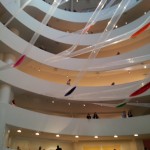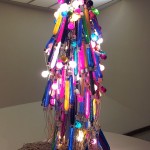WIT Life #232: Gutai at the Guggenheim
WIT Life is a periodic series written by professional Writer/Interpreter/Translator Stacy Smith (Kumamoto-ken CIR, 2000-03). She starts her day by watching Fujisankei’s newscast in Japanese, and here she shares some of the interesting tidbits and trends together with her own observations.
On Saturday I finally had the chance to check out the exhibition Gutai: Splendid Playground (Feb 15-May 8) at the Guggenheim, and it was well worth the wait. Frank Lloyd Wright’s rotunda is filled with Sadamasa Motonaga’s Work (Water), an installation of tubes filled with colored water commissioned by the museum to be recreated for this space.
Gutai (具体) literally means “concreteness” and refers to the way the members of the Kansai-based Gutai Art Association (59 Japanese artists from 1954-1972) sought to directly engage with materials in an experimental way. The group would hold festivals and other events designed to break down the barriers between art, the ordinary public and everyday life.
One interesting aspect of the movement that I wasn’t aware of was its advocacy of children and their interaction with art, as a way to develop originality and freedom of thought and action. Proceeds from events were donated to charities for children, and Gutai artists contributed to a children’s poetry and art magazine called Kirin. A 1956 article from this publication entitled “Let’s Make Mischief” differentiated between good (creativity) and bad (theft, vandalism) mischief. The artists saw themselves as being part of the former category, and were often called crazy for it.
These avant-gard e artists created captivating works using a variety of media. Kazuo Shiraga often painted with his feet, and his 1963 Wild Boar Hunting II, consisting of a wet, matted boar skin affixed to the canvas and smeared with black and red paint, is striking. Atsuko Tanka’s famous Electric Dress (1956) features a costume made from flashing colored light bulbs that she wore during performances.
e artists created captivating works using a variety of media. Kazuo Shiraga often painted with his feet, and his 1963 Wild Boar Hunting II, consisting of a wet, matted boar skin affixed to the canvas and smeared with black and red paint, is striking. Atsuko Tanka’s famous Electric Dress (1956) features a costume made from flashing colored light bulbs that she wore during performances.
The Gutai Art Manifesto states that the group was guided by no rules, just devoted to a “free site of creation wherein we have pursued diverse experimentations, ranging from art to be appreciated by the whole body to tactile art to Gutai music.” It is through this constant pursuit that Gutai artists were able to create vibrant pieces that enabled the impartation of new life to matter.


Comments are closed.